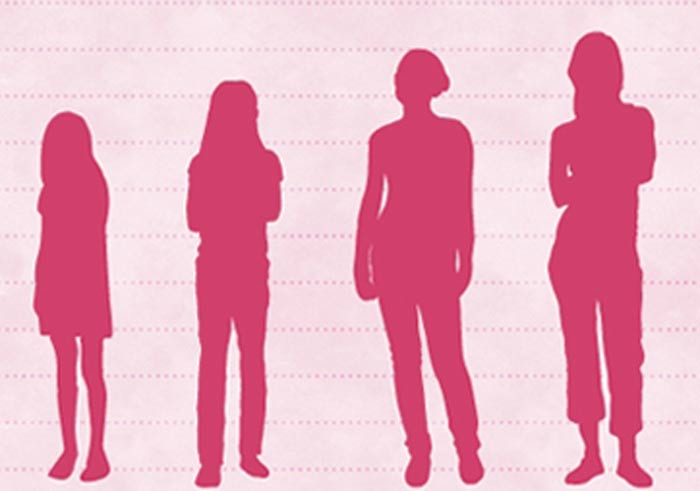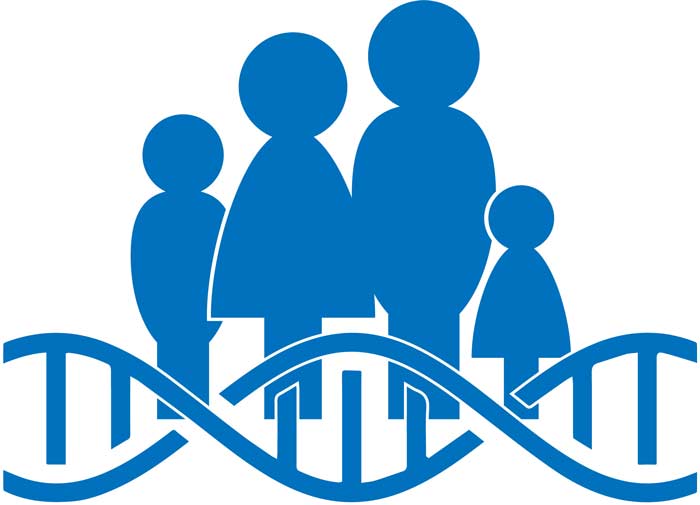Most girls wonder when they will stop growing especially in height. Female growth and development is quite a broad topic. Inhere, find details on the time your height and other body parts or organs stop growing and general development phases in women.
When do girls’ stop growing in height
Girls grow faster in height throughout their childhood as compared to boys. In most cases, the maximum height girls attain is dependent on the age when they experience their first period. Roughly, a girl will get her first period at 12 years of age.

Girls hit their lifetime heights as soon their menstruation starts. Around that time, a girl gains 1 to 2 inches in height. At around the age of 14 to 15 years, a girl can comfortably tell their adult height since there is no much height gain expected in the years to come.
Even that, there are cases when some girls are said to hit puberty at the age of 8. Their growth in height is optimal between the age of 10 and 14. If you compromise your diet, you may not grow to your optimal height. It is therefore advisable that, during puberty, you need to take a balanced diet and also, you are advised to do exercise regularly.
When do girls’ feet stop growing
According to American podiatric association, a child’s foot significantly grows in the first year after birth. How fast a girl’s foot grows or up to what length the foot grows may be determined by two major factors.
To begin with, hereditary factors majorly affect foot growth. By looking at you family and the trend of growth in the family, you can easily tell up to what length your feet will grow. Apart from that, the amount of pressure applied on your foot also affects its growth.
Unless you subject your feet to abnormal pressure that greatly interferes with the natural growth of your feet, podiatrists are in position to determine to what length your feet will grow by simply looking at your gender and age.
Leonard R. Janis explains that; a girl will have approximately 1cm foot growth each year after birth. Between birth and when the baby girl turns four, her foot length is likely to double. Most girls will have completed their foot growth by the time they are 10 years old. When the girls are about 14 years of age, their feet stop growing and that is the most probable foot length for their lifetime. [1]
When do girls’ Breast stop growing
Unlike height and feet, a girl’s breasts keep changing in size and shape and that makes it very difficult to confidently give a clear age when your breasts stop growing. Among the main factors affecting the continued growth of your breasts include; genetics and general body chemistry. This varies from one individual to another.
The first noticeable growth in size of breasts is noticed during puberty when your ovaries release estrogen. When a girl starts menstruating, the secretory glands from which milk comes from during nursing of a baby form.
The breasts get bigger as the gland system and ducts continue to grow. Connective tissues accumulation also contributes to the increased breast size. The increase in breast size during your monthly periods is temporary not unless you get pregnant during that time.
Research shows that most women reach their maximum breast size during their early 20’s. This however may not apply to every woman. During pregnancy, your breasts size may increase. Some women experience minimal growth in breast size while for some, it is an extremely huge increase.
In some cases, your breast size after breastfeeding becomes your lifetime breast size. For some, however, the breasts go back to their pre-pregnancy size. In fact, the best time to draw a conclusion that your breasts are no longer growing is right after you observe them once you breast feed your child.
This is in support of what Johns Hopkins Medicine says; that a woman’s breasts are not mature until her breastfeeding time. In conclusion, we can say that your breast will stop growing after breastfeeding. The other big change you will experience is around the age of 35 or rather when you get to menopause. At that time, your breasts shrink reducing in size and changing their shape.
Women’s Growth and Development of Organs
Several changes occur as a woman develops from childhood to adulthood. Below are some of the identified changes during female growth;
Growth of pubic hair and genitalia
Part of female growth is the growth of pubic hair and genitalia. At the initial stages, you will notice that some long soft hair begins to grow on your pubic areas. With time, the hair continues to spread and it becomes even darker. You may also have hair growing under your arms. When it is too much, some females shave it.
The National Health Service in the United States explains that, during puberty, pubic hair continues to become coarse and thick. You may take about four years to have your genitals fully developed.
Breast development
Among the most crucial parts of reproduction in women is breast development. Compared to other mammals, female human beings are special in that their breasts fully develop even before they get their young ones.
Breast development occurs in stages; before birth, during puberty and during the childbearing years. Females also report that they notice changes in their breasts during menstrual cycle and at menopause. The distinct stages of breast development are explained below;
Phase 1: The start of breast development
It is during fetal development that breasts begin to develop. They start on the chest inform of a thickening referred to as milk line or mammary ridge. When a baby is born, you will notice that beginnings of the milk line as well as nipples have developed.
Phase 2: Breast changes during puberty
At the start of puberty, girls begin to notice changes in their breast size. As explained by office of the Women’s health, during puberty, the breasts are likely to feel itchy as well as sore. Dr. Brunilda Nazario explains that breasts at puberty constantly grow up to the age of 17 or 18. Nazario also notes that one breast may grow faster than the other; however, the smaller breast catches up with time.
When ovaries start secreting estrogen, there is accumulation of fats in the connective tissue. This is what causes the breasts to enlarge. When a girl starts ovulating and menstruation begins, there is formation of secretory glands at the end of the milk ducts causing the breasts to mature.
Breasts and the duct system continually grow forming many more glands and lobules. You will however note that, the rate at which breasts grow during puberty vary from one girl to the other. Sometimes, the size of the breast is determined by genes from your parents.
Phase 3: Childbearing years
Females report that their breasts grow bigger during their child bearing years and later shrink. There is a common belief by health practitioners that a female’s breasts are not fully developed until they give birth.
Production of the hormone progesterone explains why your breasts can be used as the first sign of pregnancy. You will notice that both your breasts and areolas swell during pregnancy. The nipples become tingling and sore following development of many more lobules. Enlargement of the breasts during pregnancy is temporary and is usually in preparation for breastfeeding.
Phase 4: During menopause
By the time you are in 40’s and 50’s, you will have reached menopause or it will be underway. There is a lot of fluctuation in the levels of progesterone and estrogen. For instance, levels of estrogen suddenly decrease. This leads to reduction in glandular tissue of the breast which was previously stimulated by estrogen.
With low levels of estrogen, the breast’s connective tissue becomes inelastic and dehydrated. The breast tissue shrinks and there is a general lose in breast size. This explains why women of this age have sagging breasts. [2]
Growth of body hair
Although this is not as severe as the case in boys, girls may experience growth of hair on their hands and legs. The office on Women’s heath explains that even before a girl starts getting her periods, she may already have developed hair under her armpits and on the legs.
Factors that Influence Female Growth
There are several factors that influence female growth. Some of these factors are discussed below;
Genetic factor
In most cases, your growth depends on the genes acquired from your parents. For instance, your height can be obtained by a simple calculation using your parents’ heights;
- Subtract five inches from your father’s height
- Add the result to your mother’s height
- Divide the sum by two

Most features in your female growth are a combination of the features of your parents. That is why you can predict how your growth pattern will be by simply looking at your parents.
Nutrition
Since most growth happens during puberty, feeding well before and after puberty determines how well your female organs develop. Eating the proper foods aids a woman in growing optimally. When a girl is growing, she should be given the right amounts of calcium, proteins, and vitamins A and D in order to boost their potential of growth.
Scientific American explains that malnutrition especially during childhood affects your growth rate. In support of this, Economics and Human Biology journal explains that nutrition is one of the most common external factors that influence the European nation’s height.
Stress
Your level of stress determines how much growth hormones you produce. When you have so much stress, your growth hormones are strained. You realize that at such times your growth is slowed down. When stress is eliminated, the body releases more growth hormones.
Climate
The climate of where you live determines your growth rate especially your height. In areas of high attitudes, most people tend be short. In such places, there is a very small amount of oxygen in the air.[3]
Signs that women have Stopped Growing
Different female body organs grow to a different size at a different age. There are however common ways to tell that you are no longer growing. Some of the signs are discussed below;
Having a constant shoe and cloth size
This is the best way to tell that you are no longer growing. If the shoes in your closet are of the same size; you can comfortably conclude that your foot has reached its maximum growth. After all, there are many shoes you had to drop since they could not fit you when you were growing. Finding that one perfect shoe size is usually a joy to many.
Likewise, your clothes in the closet suddenly become of almost the same size. For instance, if you have come to a point where your waist size is constant, it is clear that you are no longer growing. The only changes you may need to make regarding the clothes is adjustments due to the continuous changes in hip size caused mainly by exercise and feeding habits.
Your bra is also another crucial sign that you are no longer growing. During your early 20’s you realize that you are in position to point out a specific bra size since your burst is at its optimal growth. This only changes during breastfeeding and the change is not that big anyway.
Looking at your family
If you have attained the common shoe size in the family or the common height in the family, this can be a big sign that you have reached your optimal growth. As already discussed, genetics determine so much how big you grow. By simply looking at your family height, you can tell at what point you are not going to grow further.
Tips to ensure Optimal & Healthy Growth in Female
To ensure Optimal and healthy development in girls, you should start it right from the early stages of growth through puberty. Having an understanding on a healthy diet and nutrition is key.
The New England Journal of Medicine stated in one of its publications that nutrition is the best way of ensuring that your growth is optimal and well maintained. This section is particularly important for parents as it boosts your choices.
Know how to measure body mass index (BMI): measuring the BMI is good for the determination of whether your child is under or overweight. This will be able to inform you on whether you should be increasing food proportions or cutting down on them and which food in particular to cut down on. Take for instance, too much body fat leads to vasoconstriction of the penile vasculature hence leading to reduced growth and size.
Healthy eating and dieting: it has been recommended that having regular meals during the day and having in-between snacks keeps your metabolism optimal and hence good for growth.
- Add a vegetable or fruit to each snacking.
- Make sure that you have more lean meat as you protein.
- Boost fiber intake. Include whole grains
- Drink plenty of water afterwards and during the day to promote digestion and optima nutrient absorption.
- Limit unhealthy foods substances such as saturated fats.

Physical exercise: The National Institute of kinesiology states that light exercises are good for stimulation of growth hormone-like hormones. Strenuous exercises have however been shown to reduce stature by causing premature ossification. So you might as well prevent this.
Avoiding stress: According to research, stress slows down production of growth hormones. Minimize stress to allow production of more growth hormones.
Sources
[1] https://www.livestrong.com/article/514495-foot-growth-in-children/
[2]https://www.hopkinsmedicine.org/healthlibrary/conditions/breast_health/normal_breast_development_and_changes_85,P00151/
[3] https://www.healthline.com/health/when-do-girls-stop-growing#heightand-genetics5

